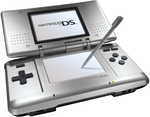Template:Featured: Difference between revisions
m (Corrected the link of an article.) |
m (Corrected the link of an article.) |
||
| Line 1: | Line 1: | ||
<noinclude>'''Please read:''' If you are going to replace the current information on the Featured template, please see [[Template:UpcomingFA|here]] before doing that and look at which order our next FAs will be put on this page. [[Category:Main page templates]]</noinclude>{{featured-image|Nintendo DS original.png|150px}} | <noinclude>'''Please read:''' If you are going to replace the current information on the Featured template, please see [[Template:UpcomingFA|here]] before doing that and look at which order our next FAs will be put on this page. [[Category:Main page templates]]</noinclude>{{featured-image|Nintendo DS original.png|150px}} | ||
The '''Nintendo DS''' is a handheld game system released by [[Nintendo]] in 2004. The Nintendo DS is Nintendo's fifth handheld system; its predecessor is the [[Game Boy Advance]]. It features two 3-inch screens. "DS" stands for "Dual Screen" (though, at its conception, it was intended to stand for "Developer's System"). The system introduces many new features to the Nintendo handheld lineup, including a resistive touchscreen, visible operating system GUI (in the form of the main menu), stereo sound output/audio input via microphone, and wireless connection capabilities. It is also the first Nintendo handheld to support 3D polygonal graphics as opposed to only sprites. The DS also introduces a feature known as sleep mode, where one can close the console and preserve its battery life. As with previous major Nintendo handhelds, the DS (and by extension the [[Nintendo DS#Nintendo DS Lite|DS Lite]]) provides backwards compatibility for Game Boy Advance games (though this does not work with the [[#Nintendo DSi and DSi XL|DSi]] models), although only limited to single-player experiences as the [[Game Boy Advance#Game Link Cable|link cable]] and [[Game Boy Advance#Wireless Adapter|wireless adapter]] support are missing. Similiar to the [[Game Boy Advance#Game Boy Micro|Game Boy Micro]], the DS and DS Lite cannot play games made for the [[Game Boy]] and [[Game Boy Color]]. The charger provided with the first generation DS is the same connection as the [[Game Boy Advance#Game Boy Advance SP|Game Boy Advance SP]]. The graphical capability of the Nintendo DS is said to be on par with the [[Nintendo 64]], albeit with enhanced 3D modeling, but more pixelated textures due to lack of texture filtering. {{more|Nintendo DS}} | The '''Nintendo DS''' is a handheld game system released by [[Nintendo]] in 2004. The Nintendo DS is Nintendo's fifth handheld system; its predecessor is the [[Game Boy Advance]]. It features two 3-inch screens. "DS" stands for "Dual Screen" (though, at its conception, it was intended to stand for "Developer's System"). The system introduces many new features to the Nintendo handheld lineup, including a resistive touchscreen, visible operating system GUI (in the form of the main menu), stereo sound output/audio input via microphone, and wireless connection capabilities. It is also the first Nintendo handheld to support 3D polygonal graphics as opposed to only sprites. The DS also introduces a feature known as sleep mode, where one can close the console and preserve its battery life. As with previous major Nintendo handhelds, the DS (and by extension the [[Nintendo DS#Nintendo DS Lite|DS Lite]]) provides backwards compatibility for Game Boy Advance games (though this does not work with the [[Nintendo DS#Nintendo DSi and DSi XL|DSi]] models), although only limited to single-player experiences as the [[Game Boy Advance#Game Link Cable|link cable]] and [[Game Boy Advance#Wireless Adapter|wireless adapter]] support are missing. Similiar to the [[Game Boy Advance#Game Boy Micro|Game Boy Micro]], the DS and DS Lite cannot play games made for the [[Game Boy]] and [[Game Boy Color]]. The charger provided with the first generation DS is the same connection as the [[Game Boy Advance#Game Boy Advance SP|Game Boy Advance SP]]. The graphical capability of the Nintendo DS is said to be on par with the [[Nintendo 64]], albeit with enhanced 3D modeling, but more pixelated textures due to lack of texture filtering. {{more|Nintendo DS}} | ||
Revision as of 13:17, September 20, 2023
Please read: If you are going to replace the current information on the Featured template, please see here before doing that and look at which order our next FAs will be put on this page.
The Nintendo DS is a handheld game system released by Nintendo in 2004. The Nintendo DS is Nintendo's fifth handheld system; its predecessor is the Game Boy Advance. It features two 3-inch screens. "DS" stands for "Dual Screen" (though, at its conception, it was intended to stand for "Developer's System"). The system introduces many new features to the Nintendo handheld lineup, including a resistive touchscreen, visible operating system GUI (in the form of the main menu), stereo sound output/audio input via microphone, and wireless connection capabilities. It is also the first Nintendo handheld to support 3D polygonal graphics as opposed to only sprites. The DS also introduces a feature known as sleep mode, where one can close the console and preserve its battery life. As with previous major Nintendo handhelds, the DS (and by extension the DS Lite) provides backwards compatibility for Game Boy Advance games (though this does not work with the DSi models), although only limited to single-player experiences as the link cable and wireless adapter support are missing. Similiar to the Game Boy Micro, the DS and DS Lite cannot play games made for the Game Boy and Game Boy Color. The charger provided with the first generation DS is the same connection as the Game Boy Advance SP. The graphical capability of the Nintendo DS is said to be on par with the Nintendo 64, albeit with enhanced 3D modeling, but more pixelated textures due to lack of texture filtering. Template:More
